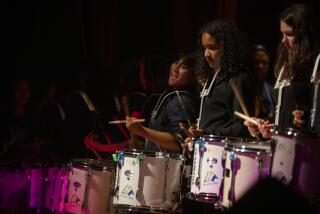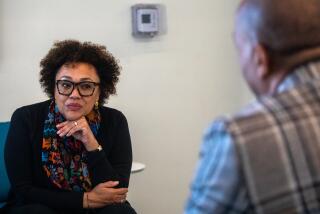ARTS BUDGET: PUSH COMES TO SHOVE
- Share via
WASHINGTON — The chairman of the National Endowment for the Arts, presenting the Reagan Administration’s $20-million-trimmed arts-budget proposal Thursday, got into a verbal sparring match with Rep. Sidney R. Yates (D-Ill.), chairman of the congressional subcommittee that handles the arts budget.
Without ceremony, Yates submitted into the record, NEA Chairman Frank Hodsoll’s 10-page testimony arguing that the agency could be reduced from this year’s $165.1 million to a proposed $145.2 million and still “provide substantial funding for the best of the nation’s arts activities, stimulate the network of public and private contribution” and “exercise leadership” on behalf of the arts.
Hodsoll, who had been a deputy assistant to the President before being named the endowment’s chairman in late 1981, reminded the subcommittee that the endowment’s reduced request is “also consistent with our desire to assist in the reduction of the federal budget.”
The confrontation wasn’t a first between the NEA chairman and the chairman of the House Appropriations interior subcommittee that handles the arts budget.
The Reagan Administration consistently has sought to reduce federal spending on the arts; Yates’ committee consistently has approved more than was requested. But the 77-year-old Yates was more challenging Thursday, firing a series of district-attorney-like questions at Hodsoll.
“I ask you,” Yates said with a touch of sarcasm, “last year we gave you $20 million more than you asked for. Was that $20 million too much?”
Hodsoll replied that the extra money was “spent satisfactorily.” But in light of the nation’s budget deficit, and with the “constraints” of the Gramm-Rudman-Hollings budget-balancing law he said, “every agency has to provide a share to reach these targets.”
“How much of a beating would the arts have to take if we approved your figure?” Yates asked.
Hodsoll replied that $20 million was “a very small margin compared to nonprofit arts support,” which amounts, he said, to $10 billion annually.
Later in the hearing, questioned about that amount, Hodsoll said he was including a “ballpark figure” of about $5 billion in ticket sales and $5 billion from private donations to cultural endeavors in 1985.
In his formal testimony, Hodsoll noted that, according to recent figures of the American Assn. of the Fundraising Counsel, a nonprofit organization that monitors charitable contributions, private giving to the arts increased in 1985 by 13% over the previous year--to $5.09 billion. That represents an increase of 62% since 1980, he said.
But Yates stated flatly that “you and I know that private sector giving can’t make up the difference.” Hodsoll disputed that.
In contrast to the grim statistics offered two weeks ago when representatives of national theater, symphony, opera and museum organizations testified before the subcommittee, Hodsoll painted a brighter picture using different numbers.
Citing the Bureau of Economic Analysis, a private academic organization with quasi-official status, Hodsoll said that revenues for nonprofit performing arts events in 1985 increased 11%, and for the first time exceeded revenues from admission to sporting events.
He also noted that the “real” (adjusted for inflation) gross national product grew 2.7% in fiscal 1986, which ended last Sept. 30, and is expected to grow another 3.2% in the current fiscal year. “This growth should encourage the arts generally,” Hodsoll said.
The specifics of Hodsoll’s funding request include an 8.6% increase for administrative funds--”attributable to government-wide mandated increases in fixed costs”--and a string of reductions for the endowment’s various programs: from the current $10.8 million to $8.9 million in theater-program funds, from $15.3 million to $12.6 million in music-program funds, from $12.3 million to $9.9 million in museum-program funds, from $6.1 million to $5.1 million in opera/musical theater-program funds, and from $9.1 million to $7.4 million in dance-program funds.
Yates asked Hodsoll what he thought would happen if Congress gave the endowment $200 million--the amount that the American Arts Alliance and other leading national arts organizations are asking.
Hodsoll answered that if Congress applied the same attitude to other federal departments and agencies across the board, the national deficit would balloon to $400 billion.
At the subcommittee’s hearing two weeks ago, actor Richard Kiley made a stirring plea on behalf of support for the individual artist. Hodsoll provided statistics to flesh out that issue, noting that during the past fiscal year, while 3,700 grants were made to organizations and agencies totaling $135 million, nearly 775 individual grants and fellowships were awarded totaling $8 million, or less than 6% of the grants total.
Under further questioning by Yates, Hodsoll discussed the decline in oil companies’ sponsorship of public-television broadcasts. He said the endowment is actively seeking other sponsors, and that while “I don’t have a great deal to report on that, I am optimistic we will find the funding.”
At Hodsoll’s indication of concern, Yates interjected: “You have to worry. If you are not married to the Corporation for Public Broadcasting, you are at least engaged to it.”
Hodsoll’s annual appearance before Yates’ subcommittee provided the chairman the opportunity to talk about new NEA initiatives, including making the arts a basic in education and the endowment’s revamped design for its big-money challenge-grant program.
He said the endowment has “entered into a partnership” with the J. Paul Getty Trust to develop a television series aimed at children aged 8 to 10. To complete research and development of three pilot programs, the endowment has awarded funding to public-TV station WNET in New York. “If successful, the series will have accompanying printed materials which we hope will eventually be used by teachers in the classrooms,” Hodsoll said.
Hodsoll also mentioned “some promising developments” involving cultural exchange with other Western Hemisphere nations. He said record audiences attended the New York Shakespeare Festival’s Festival Latino last September, and that plans are under way for a Pan-American Arts Festival in Indianapolis in August.
More to Read
The biggest entertainment stories
Get our big stories about Hollywood, film, television, music, arts, culture and more right in your inbox as soon as they publish.
You may occasionally receive promotional content from the Los Angeles Times.










